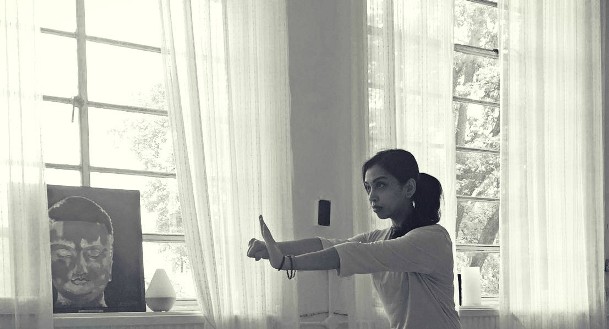
What if I revealed a secret worth gold, that I’ve been restoring depleted vitality and lack of strength in my body by doing nothing?
Okay—not nothing. Close to nothing.
I do this just by standing.
And what if I suggested that the key to better physical movement is in stillness—that there is magic in being still?
You might just believe me when you try this standing meditation that I’ve been doing daily, for over a month now.
I’m referring to the art of Zhan Zhuang, a form of internal martial arts from the Daoist tradition, literally translated into “standing like a pole.” Grandmaster Wong Kiew Kit, writer of the famed The Art of Shaolin Kung Fu says it means “standing at stances’’ (from Mandarin) and is therefore used as a training exercise for martial artists.
I’m a writer, an advisor, a yoga teacher and a martial arts practitioner, and I’ve struggled with a lot of exhaustion—not from these practices, but generally from life’s challenges—until now.
Why practice Zhan Zhuang?
This effortless standing practice is designed to heal the self on multiple levels: the mind, the physical body, the emotions and spirit—this has been my experience, anyway. For me it is another form of yoga practice, the unification of all aspects of being—mind, body and spirit—and so, I incorporate it regularly in my yoga classes.
I also combine this pole standing technique within my Qiqong practice, a similar energy art from the Chinese tradition, though considered different from Zhan Zhuang, because of its aims and intentions. Qigong is more widely practiced for its medical and spiritual benefits, whereas Zhan Zhuang’s purpose is to carry out martial art feats. The arts have blurred nonetheless because they look and feel the same.
Like Qigong, there are other postures to take as you “stand like a pole,” however as a novice, just standing effortlessly is the best and safest place to start!
How to do it:
>> Begin by standing in an empty posture—arms hanging gently by your sides, feet shoulder width apart, soft bend in the knees and chin drawn slightly in.
>> Keep your spine and chest upright, pelvis neutral and weight distributed evenly between your feet.
>> Consciously begin to relax each part of your body. Practice abdominal breathing; allow the belly to rise and fall with every inhale and exhale. Become aware of your mind. Empty it.
>> Now visualise yourself as a tree rooted down into the ground. Allow your body to sway to begin with; go with the flow, you’re playing with gravity!
>> An option, when you feel rooted, is to lift your arms parallel to your chest as if you were hugging a tree. Palms facing inward.
>> Rest in this stance with eyes closed or softly gazing downward.
>> Hold the stance for 20 seconds a day leading up to 30 seconds and then a minute, then two—slowly over time build your way to five minutes or more.
What are the benefits of this stance practice?
I tested out the meditation practice around nine years ago to improve my mental training in Kung Fu, but it’s only now that I practice it daily, reaping the full rewards through self-discipline!
Zhan Zhuang can build internal as well as physical strength, restore energy, help body alignment, calm the mind and provide focus. It also helps ground the body and stabilise emotions. With a five-minute daily practice, I have experienced all of these benefits and my martial arts training has strikingly improved in the realms of stamina and rootedness in stance work.
I’ve been lucky enough to be taught correctly. If you can find a good instructor to help you by all means seek her/him out. In the mean time you can follow my above instruction.
Here’s the wisdom I’ve learned: Through effortless routine practice comes powerful gains.
The key is to get embodied; to visualize being rooted into the earth, to focus on breath and to do this daily!
Who is this standing meditation for?
For everyone, of course! But if you’re a writer, an office worker or someone who sits in a chair for most part of the day, I’d definitely recommend taking out time to do this stance training; either in the morning, at lunch time or before bed.
If you’re struggling emotionally or going through a hard time, this is another way to open to stillness and align with your center.
“In silence there is eloquence. Stop weaving and watch how the pattern improves.” ~ Rumi
Stop doing. Start being. Heal yourself with this wonderful standing art.
Author: Payal Patel
Image: Courtesy of author
Editor: Catherine Monkman






Read 0 comments and reply